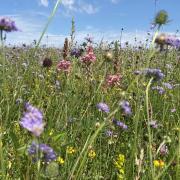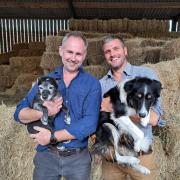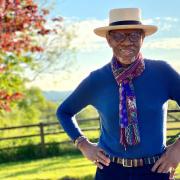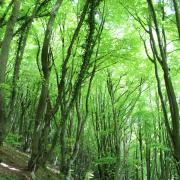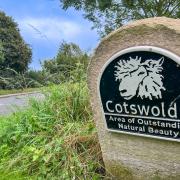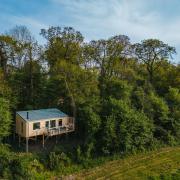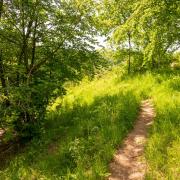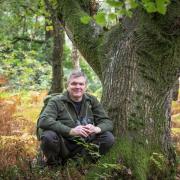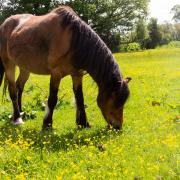There’s a growing buzz around ‘regenerative agriculture’. So, what’s it all about?
In its most general terms regenerative agriculture refers to sustainable farming that at the same time improves the environment, Mark Connelly, Land Management Lead at Cotswolds National Landscape, explains. It is based on core principles that aim to improve the health of soil and pasture. These include: minimising soil disturbance; growing a diverse range of crops; keeping surface soil covered and living roots in soil; integrating grazing livestock into the farming system.
‘There are all sorts of benefits from such practices,’ Mark continues. ‘Getting soils into a better condition enables chemical use to be reduced. Your livestock are healthy because they are grazed on more diverse sward or herb-rich leys, which have more deep-rooted plants and are more drought-tolerant. Higher water retention also contributes to natural flood management and, because you are increasing organic content and growing your soils they hold carbon. You are also increasing biodiversity.’

For decades farmers have been pushed to maximise production yet keep costs to consumers low, and have moved away from traditional mixed farming practices of rotational leys and livestock, towards more chemical-based systems with artificial fertilisers and pesticides, causing a lot of soil depletion, Mark says. ‘Cotswold soils have always been thin, but they are even thinner now. The farming sector and science have realised the error of what has happened and regenerative agriculture seeks to correct it.
‘If you find an old farmer in his 90s and talk to them about regenerative agriculture, they will tell you it is pretty much what they used to do!’ Mark adds. ‘So in some ways it is taking a step back to more traditional farming – but with a modern twist and more science behind it.’
THE COW & THE HOW
Every farm is different and so approaches to regenerative agriculture vary. Whittington Lodge Farm near Cheltenham is just one example of what can be done (www.cotswoldbeef.com). For readers who don’t already know: Ian Boyd and his wife Cathy, daughter Steph and son-in-law Fred farm organic, Pasture for Life, pedigree Hereford cattle alongside organic arable crops, in harmony with managing wildlife habitats, across 700 acres.
Some two decades ago, motivated to increase farmland wildlife (Ian’s passion is wildlife photography) and by the saying ‘be the change you want to see in the world’, the family altered its farming systems – and became regenerative farmers before the term had been invented.
How does it work? ‘We adopt a very low input approach – no [bought-in] feed or chemical fertilisers – and we are developing a high output through our cattle enterprise,’ Ian says.
On the arable side they avoid the use of chemicals to control weeds and adopt a ‘minimal plough’ approach when growing their spring barley. They rotate growing this crop with several ‘fertility-building’ years in between when they don’t disturb the soil and grow grass, legumes and herbs.
Their cattle, which they brought in to manage the farmland and habitat, live outdoors year-round and graze on the herb-rich arable break-crop, permanent pasture and wildflower meadows. ‘We keep moving them around in the mob grazing principle,’ Ian says. Effectively the cattle eat one third of the grass, trample one third (helping to increase soil organic matter) and leave one third, which then develops long roots and helps to lock carbon into the ground. ‘It’s about getting the soil right, so that it gets the insects right, and you get a better diversity of plants, and then you get more birds. It’s a gradual process.’

Meat produced from grazing only what is grown on the farm means it has its own, distinctive flavour, and ‘eat less meat, eat better meat’ is a key consumer message, Fred says. With the cattle being intrinsic to the management of the farmland habitat and arable rotation, qualms people might raise over red meat production being linked to the climate crisis can be countered with Ian’s saying: ‘It’s not the cow, it’s the how.’ Using the Farm Carbon Toolkit in calculations, he says the farm is ‘around net zero’. At the time of our discussion, Ian is a finalist for two Farmers Weekly national awards, Grassland Farmer of the Year and Environmental Champion of the Year.
Wildlife on the farm flourishes, from winter fieldfares and stonechats to roe deer, buzzards, kestrels and ‘lots of owls,’ Steph says. Quite apart from helping to promote the long-term sustainability of the farming system, the ‘natural capital’ of healthy soil, biodiversity and wildlife has benefited farm diversifications such as their self-catering accommodation business, Fred adds. ‘We take most of our guests on a farm tour and that is what people rave about in reviews.’
Steph and Fred are spearheading the farm’s new Sainfoin Centre of Regenerative Agriculture, created in a large converted farm building with the help of a Farming in Protected Landscapes grant (administered by the Cotswolds National Landscape team). Sainfoin, aka Holy Hay, grows in the farm’s herbal leys and wildflower meadows, is highly palatable to cattle, ‘anti-bloat’ (reducing methane production), a natural aid to controlling worms in cows’ guts, and is its own nitrogen fixer and a magnet for insects: a perfect emblem for the family’s holistic approach to farming.


A multi-purpose space with a demonstration kitchen area, the centre will host events, workshops and farm tours for both members of the public and other farmers to explore sustainable farming systems.
‘It’s about showing how farming can be an essential part of the solution to both the biodiversity and climate change crises,’ Ian says. Changing attitudes within the farming world, sharing information and learning from each other is the way forward, they say.
GOOD NEWS FOR THE LANDSCAPE
‘Different farms will move to regenerative agriculture in different ways,’ Mark Connelly reiterates, ‘for example with more varied crop rotations.’ Farming in Protected Landscapes grants have been made to support numerous farms on their journey towards healthy, sustainable systems – project highlights can be found on the Cotswolds National Landscape website.
‘The Cotswolds is a landscape that was created by farming and we need farming to help restore, conserve and enhance the landscape,’ Mark says. ‘If farms can adopt regenerative agriculture principles and be profitable, that is good news for the landscape, too.’






